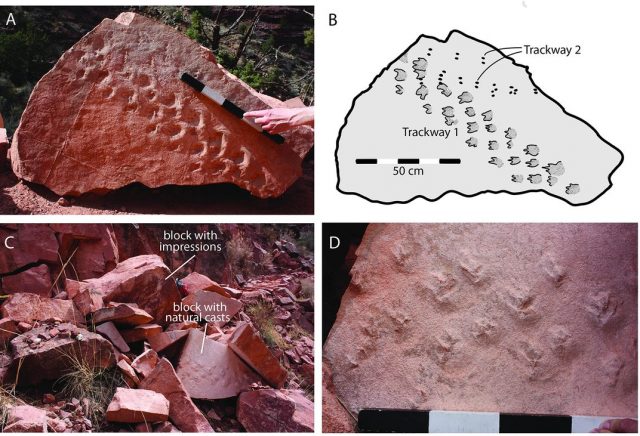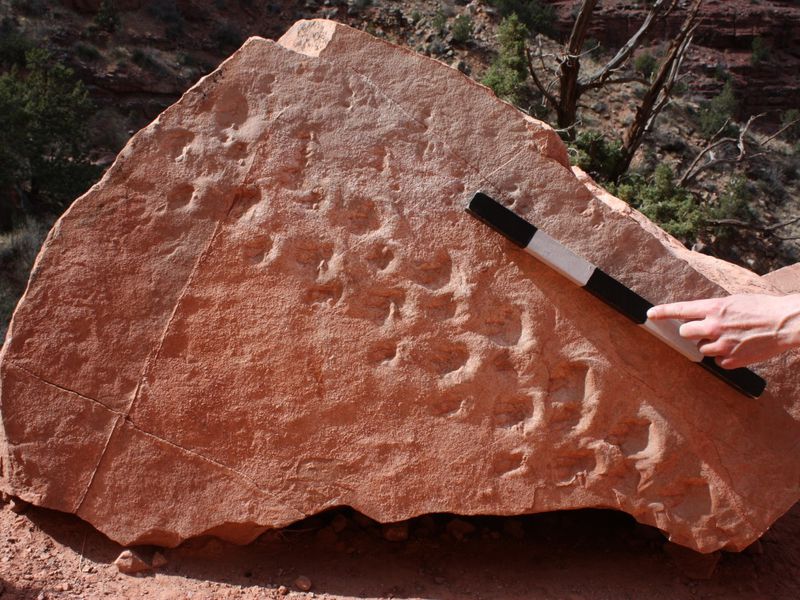It’s not all that unusual for folks to come across occasional fossil marks etched in stones in the Grand Canyon.
After the all, the region has been in existence for millennium, and has proven itself to be a rich source of information and research material for paleontologists and geologists right across America.
A 2016 find, however, was not the result of an ambitious expedition of paleontologists and other dinosaur researchers trudging through the rocks and up hills, determined to find evidence of some long extinct species that once roamed the canyon.
This discovery was, almost literally, stumbled upon by a geologist who was out for a hike one fine summer day. Geologist Allan Krill was simply enjoying getting a little exercise with his students in this national park.

He came upon a huge rock, one weighing several hundreds of pounds, and noticed markings that, upon closer inspection, Krill knew were not random or simply the result of weather and time chipping away at the boulder.
As an expert on rock formations, he knew instinctively that this was a rare find, with markings so odd that he called a friend, paleontologist Stephen Rowland. Upon examining photographs Krill had taken, Rowland came to the conclusion that the markings were ancient, fossilized footprints of unknown origin, and he became determined to find out what creature had made them, if possible, and when they were made.
A report on the find first appeared in 2018, but Rowland has published updated findings in a new report in PLOS One, an academic, peer reviewed journal published by the Public Library of Science in the United States since 2007.
He is confident the markings were created by some kind of reptile, a lizard, some species that predates dinosaurs. Furthermore, he estimates the footprints are more than 310 million years old – the oldest fossil ever found in the park to date.
The shape of the tracks led to Rowland’s conclusion that it was a reptile that left them, but whether it was one that crossed the boulder twice, or two separate creatures, Rowland can’t say.
In fact, some of the theories he puts forth in his report could be described as controversial, as using tracks to assess how old the fossil is, as well as the creature that made them, is not a practise all experts agree is legitimate.
Nonetheless, Rowland is enthusiastic about his findings, and thinks Krill’s discovery represented an exciting advance for paleontology. The age of the fossil alone, he says, quite apart from the species that made it, is cause for celebration.
“These are by far the oldest vertebrae tracks in Grand Canyon,” Rowland insists in his report.
Although some in his profession concur, others are more cautious about Rowland’s theories. Mark Nebel is the paleontologist program manager at the park, and he is less certain that the boulder represents the huge advances claimed by Rowland.
He told the media recently, “There’s a lot of disagreement in the scientific community about interpreting tracks, interpreting the age of rocks, (and) especially interpreting what kind of animal that made these tracks.” Still, Nebel agrees that the boulder was an important discovery – just not the profound step forward Rowland feels it is.
But that is the nature of almost all scientific disciplines; experts make discoveries and then debate the merit and significance of them within their professional circles.
And we, as “lay people” outside those circles, benefit from the discoveries, the insights, and the advances made, regardless of how truly profound the findings are to the experts.
Another Article From Us: SS Cotopaxi Vanished in the Bermuda Triangle, Has Been Found 95 Years Later
Whether the boulder in question is truly 313 million years old or somewhat younger doesn’t really matter; the fossilized footprints teach us a great deal about a species that once roamed over the canyon, in an era long past.
